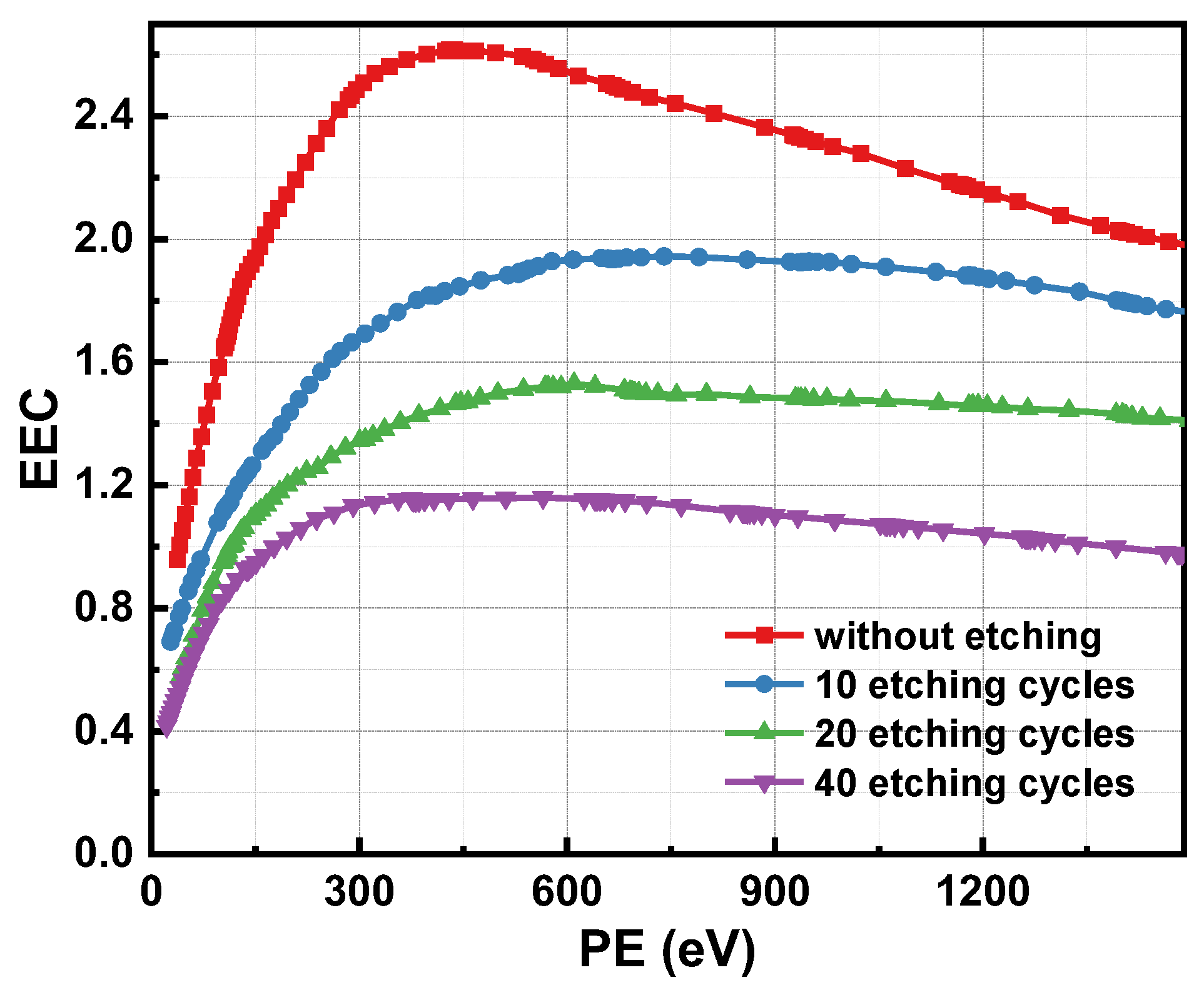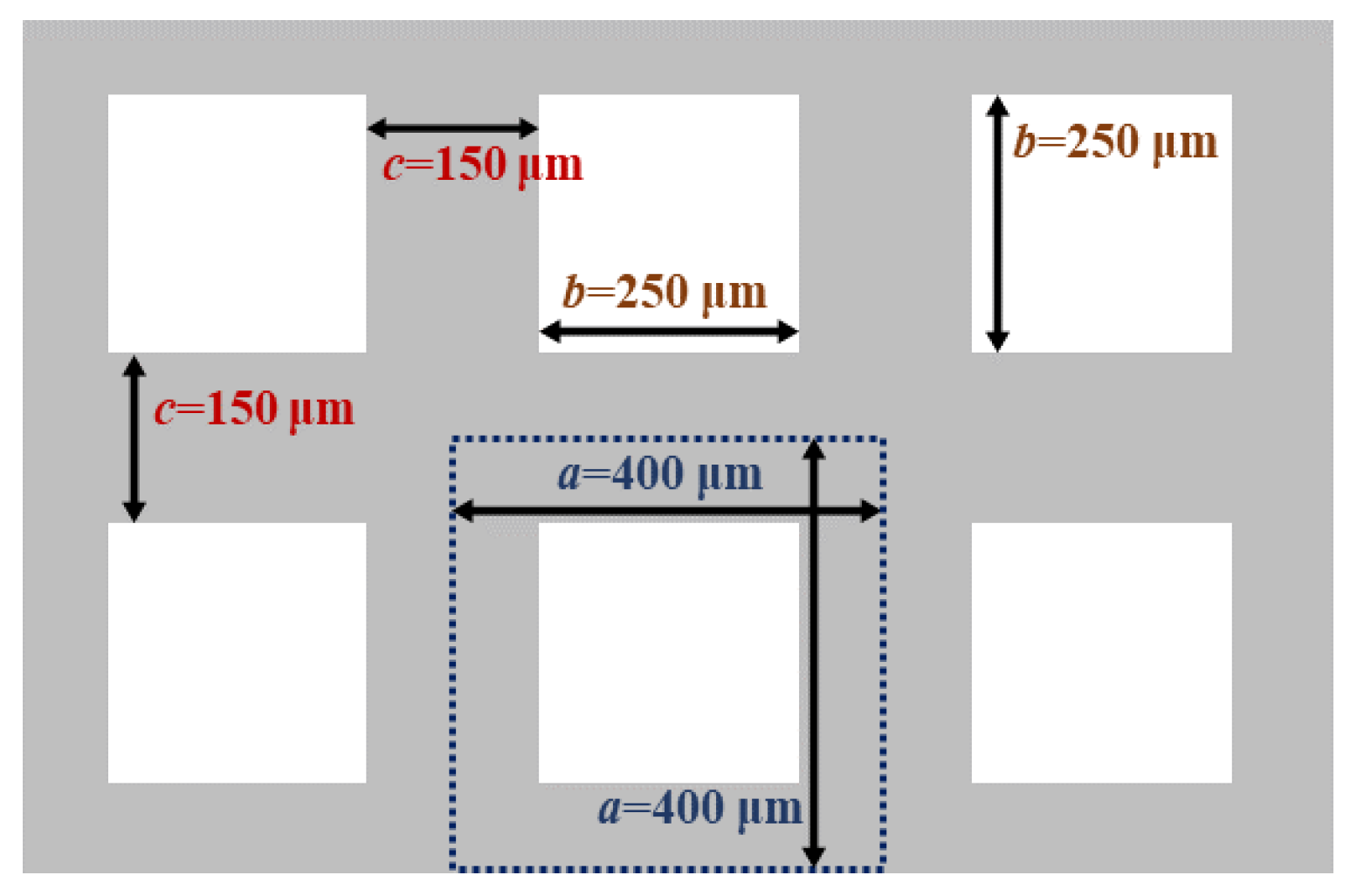Investigation on the Electron Emission Regularity of Sputtered Boron Nitride Thin Films and Microstructured Array Surfaces
Abstract
1. Introduction
2. Results and Discussion
2.1. Morphology, Surface Components, and EEC Results of BN Films
2.2. Morphologic and EEC Results of BN Bulk Samples
2.3. Theoretical Study and Simulation of Surface Microstructure Effect on EEC
3. Materials and Methods
3.1. BN Film Preparation
3.2. BN Bulk Etching Method
3.3. Physical Characterization Methods
4. Conclusions
Author Contributions
Funding
Institutional Review Board Statement
Informed Consent Statement
Data Availability Statement
Conflicts of Interest
References
- Shayeganfar, F.; Shahsavari, R. Electronic and pseudomagnetic properties of hybrid carbon/boron-nitride nanomaterials via ab-initio calculations and elasticity theory. Carbon 2016, 99, 523–532. [Google Scholar]
- Zhou, J.; Wang, Q.; Sun, Q.; Jena, P. Electronic and magnetic properties of a BN sheet decorated with hydrogen and fluorine. Phys. Rev. B 2010, 81, 085442. [Google Scholar]
- Bello, I.; Chan, C.Y.; Zhang, W.J.; Chong, Y.M.; Leung, K.M.; Lee, S.T.; Lifshitz, Y. Deposition of thick cubic boron nitride films: The route to practical applications. Diam. Relat. Mater. 2005, 14, 1154–1162. [Google Scholar] [CrossRef]
- Levchenko, I.; Xu, S.; Teel, G.; Mariotti, D.; Walker, M.L.R.; Keidar, M. Recent progress and perspectives of space electric propulsion systems based on smart nanomaterials. Nat. Commun. 2018, 9, 879. [Google Scholar] [CrossRef]
- Barral, S.; Makowski, K.; Peradzynski, Z.; Gascon, N.; Dudeck, M. Wall material effects in stationary plasma thrusters. II. Near-wall and in-wall conductivity. Phys. Plasmas 2003, 10, 4137–4152. [Google Scholar]
- Burton, T.; Schinder, A.M.; Capuano, G.; Rimoli, J.J.; Walker, M.L.R.; Thompson, G.B. Plasma-induced erosion on wall structures in Hall-effect thrusters. J. Propul. Power 2014, 30, 690–695. [Google Scholar]
- Meezan, N.B.; Gascon, N.; Cappelli, M.A. Linear geometry Hall thruster with boron nitride and diamond walls. In Proceedings of the 27th International Electric Propulsion Conference, Pasadena, CA, USA, 15–19 October 2001. [Google Scholar]
- Lian, Z.X.; Li, D.J.; Wang, D.; He, Y.N. Discharge characteristics of the planar microscale gap electrodes with various geometry structures in the atmosphere environment. Results Phys. 2024, 62, 107823. [Google Scholar] [CrossRef]
- Gascon, N.; Dudeck, M.; Barral, S. Wall material effects in stationary plasma thrusters. I. Parametric studies of an SPT-100. Phys. Plasmas 2003, 10, 4123–4136. [Google Scholar]
- Locke, S.; Shumlak, U.; Fife, J.M. A Numerical Study of the Effect of Channel Insulator Discontinuity on Hall Thruster Discharge. In Proceedings of the 27th International Electric Propulsion Conference, Pasadena, CA, USA, 15–19 October 2001. [Google Scholar]
- Chang, H.Y.; Alvarado, A.; Weber, T.; Marian, J. Monte Carlo modeling of low-energy electron-induced secondary electron emission yields in micro-architected boron nitride surfaces. Nucl. Instrum. Methods B 2019, 454, 14–22. [Google Scholar]
- Lian, Z.X.; Xu, Y.N.; Meng, X.C.; Wang, D.; Chen, J.X.; Qi, K.C.; He, Y.N. Secondary electron emission reduction from boron nitride composite ceramic surfaces by the artificial microstructures and functional coating. J. Phys. D Appl. Phys. 2024, 57, 315304. [Google Scholar]
- Seiler, H. Secondary electron emission in the scanning electron microscope. J. Appl. Phys. 1983, 54, R1–R18. [Google Scholar]
- Lee, J.; Jeong, T.; Yu, S.G.; Jin, S.; Heo, J.; Yi, W.; Jeon, D.; Kim, J.M. Thickness effect on secondary electron emission of MgO layers. Appl. Surf. Sci. 2001, 174, 62–69. [Google Scholar]
- Lian, Z.X.; Zhu, X.P.; Wang, D.; Meng, X.C.; He, Y.N. Effect of atmospheric environment on the stability of secondary electron emission from magnesium oxide and alumina surfaces. J. Phys. D Appl. Phys. 2023, 57, 125302. [Google Scholar]
- Cazaux, J. Calculated influence of work function on SE escape probability and Secondary Electron Emission yield. Appl. Surf. Sci. 2010, 257, 1002–1009. [Google Scholar]
- Gineste, T.; Belhaj, M.; Teyssedre, G.; Puech, J. Investigation of the electron emission properties of silver: From exposed to ambient atmosphere Ag surface to ion-cleaned Ag surface. Appl. Surf. Sci. 2015, 359, 398–404. [Google Scholar]
- Fijol, J.J.; Then, A.M.; Tasker, G.W.; Soave, R.J. Secondary-electron yield of SiO2 and Si3N4 thin-films for continuous dynode electron multipliers. Appl. Surf. Sci. 1991, 48–49, 464–471. [Google Scholar]
- Lapington, J.S.; Thompson, D.P.; May, P.W.; Fox, N.A.; Howorth, J.; Milnes, J.; Taillandier, V. Investigation of the secondary emission characteristics of CVD diamond films for electron amplification. Nucl. Instrum. Methods A 2009, 610, 253–257. [Google Scholar]
- Cimino, R.; Collins, I.R.; Furman, M.A.; Pivi, M.; Ruggiero, F.; Rumolo, G.; Zimmermann, F. Can Low-Energy Electrons Affect High-Energy Physics Accelerators? Phys. Rev. Lett. 2004, 93, 014801. [Google Scholar]
- Le Pimpec, F.; Kirby, R.E.; King, F.K.; Pivi, M. The effect of gas ion bombardment on the secondary electron yield of TiN, TiCN and TiZrV coatings for suppressing collective electron effects in storage rings. Nucl. Instrum. Methods A 2006, 564, 44–50. [Google Scholar]
- Hueso, J.; Vicente, C.; Gimeno, B.; Boria, V.E.; Marini, S.; Taroncher, M. Multipactor Effect Analysis and Design Rules for Wedge-Shaped Hollow Waveguides. IEEE Trans. Electron Dev. 2010, 57, 3508–3517. [Google Scholar]
- Meng, X.C.; Xu, Y.N.; Lian, Z.X.; Wang, J.Y.; Wang, D.; Qi, K.C. Secondary roughness effect of surface microstructures on secondary electron emission and multipactor threshold for PTFE-filled and PI-filled single ridge waveguides. J. Phys. D Appl. Phys. 2024, 57, 265301. [Google Scholar] [CrossRef]
- Pivi, M.; King, F.K.; Kirby, R.E.; Raubenheimer, T.O.; Stupakov, G.; Le Pimpec, F. Sharp reduction of the secondary electron emission yield from grooved surfaces. J. Appl. Phys. 2008, 104, 104904. [Google Scholar] [CrossRef]
- Watts, C.; Gilmore, M.; Schamiloglu, E. Effects of laser surface modification on secondary electron emission of copper. IEEE Trans. Plasma Sci. 2011, 39, 836–841. [Google Scholar] [CrossRef]
- Nistor, V.; González, L.A.; Aguilera, L.; Montero, I.; Galán, L.; Wochner, U.; Raboso, D. Multipactor suppression by micro-structured gold/silver coatings for space applications. Appl. Surf. Sci. 2014, 315, 445–453. [Google Scholar] [CrossRef]
- Montero, I.; Mohamed, S.H.; García, M.; Galán, L.; Raboso, D. Effect of surface reactions of low-energy carbon ions on the secondary electron emission of TiN:O thin films. J. Appl. Phys. 2007, 101, 113306. [Google Scholar] [CrossRef]
- Lian, Z.X.; Wang, D.; Zhu, X.P.; He, Y.N. High-performance microchannel plates based on atomic layer deposition for the preparation of functional layers. J. Phys. D Appl. Phys. 2025, 58, 115106. [Google Scholar] [CrossRef]
- Henrist, B.; Hilleret, N.; Scheuerlein, C.; Taborelli, M. The secondary electron yield of TiZr and TiZrV non-evaporable getter thin film coatings. Appl. Surf. Sci. 2001, 172, 95–102. [Google Scholar] [CrossRef]
- Prodanovic, V.; Chan, H.W.; Mane, A.U.; Elam, J.W.; Minjauw, M.M.; Detavernier, C.; Harry, V.D.G.; Sarro, P.M. Effect of thermal annealing and chemical treatments on secondary electron emission properties of atomic layer deposited MgO. J. Vac. Sci. Technol. A 2018, 36, 06A102. [Google Scholar] [CrossRef]
- Ruiz, A.; Román, E.; Lozano, P.; García, M.; Galán, L.; Montero, I.; Raboso, D. UHV reactive evaporation growth of titanium nitride thin films, looking for multipactor effect suppression in space applications. Vacuum 2007, 81, 1493–1497. [Google Scholar] [CrossRef]
- Thomas, S.; Pattinson, E.B. The controlled preparation of low SEE surfaces by evaporation of metal films under high residual gas pressures. J. Phys. D Appl. Phys. 1970, 3, 1469–1474. [Google Scholar] [CrossRef]
- Valizadeh, R.; Malyshev, O.B.; Wang, S.; Zolotovskaya, S.A.; Allan Gillespie, W.; Abdolvand, A. Low secondary electron yield engineered surface for electron cloud mitigation. Appl. Phys. Lett. 2014, 105, 231605. [Google Scholar]
- Dunaevsky, A.; Raitses, Y.; Fisch, N.J. Secondary electron emission from dielectric materials of a Hall thruster with segmented electrodes. Phys. Plasmas 2003, 10, 2574–2577. [Google Scholar]
- de Lara, J.; Pérez, F.; Alfonseca, M.; Galán, L.; Montero, I.; Román, E.; Garcia-Baquero, D.R. Multipactor prediction for on-board spacecraft RF equipment with the MEST software tool. IEEE Trans. Plasma. Sci. 2006, 34, 476–484. [Google Scholar]
- Vaughan, J.R. A new formula for secondary emission yield. IEEE Trans. Electron. Dev. 1989, 36, 1963–1967. [Google Scholar]
- Furman, M.A.; Pivi, M. Probabilistic model for the simulation of secondary electron emission. Phys. Rev. Spec. Top.-Accel. Beams 2002, 5, 124404. [Google Scholar]
- Dionne, G.F. Effects of secondary electron scattering on secondary emission yield curves. J. Appl. Phys. 1973, 44, 5361–5364. [Google Scholar]
- Young, J.R. Penetration of electrons and ions in aluminum. J. Appl. Phys. 1956, 27, 1–4. [Google Scholar]
- Lane, R.O.; Zaffarano, D.J. Transmission of 0–40 keV electrons by thin films with application to beta-ray spectroscopy. Phys. Rev. 1954, 94, 960–964. [Google Scholar]
- Cai, Y.H.; Wang, D.; Qi, K.C.; He, Y.N. Measurement of total electron emission yield of insulators based on self-terminating charge neutralization. Rev. Sci. Instrum. 2022, 93, 055103. [Google Scholar]









| Sample | EEC Peak Value | Most Probable PE Energy |
|---|---|---|
| BN film #1 before ion cleaning | 2.99 | 297 eV |
| BN film #2 before ion cleaning | 3.06 | 316 eV |
| BN film #1 after ion cleaning | 3.14 | 370 eV |
| BN film #2 after ion cleaning | 3.24 | 293 eV |
| Sample | Square Length b | Pore Depth h | Porosity P | Aspect Ratio |
|---|---|---|---|---|
| BN bulk with 10 etching cycles | 255 μm | 111 μm | 40.5% | 0.44 |
| BN bulk with 20 etching cycles | 261 μm | 224 μm | 42.5% | 0.86 |
| BN bulk with 40 etching cycles | 280 μm | 381 μm | 49.1% | 1.36 |
| Sample | EEC Peak Value | Most Probable PE Energy |
|---|---|---|
| BN bulk without etching | 2.62 | 437 eV |
| BN bulk with 10 etching cycles | 1.94 | 740 eV |
| BN bulk with 20 etching cycles | 1.53 | 610 eV |
| BN bulk with 40 etching cycles | 1.16 | 565 eV |
Disclaimer/Publisher’s Note: The statements, opinions and data contained in all publications are solely those of the individual author(s) and contributor(s) and not of MDPI and/or the editor(s). MDPI and/or the editor(s) disclaim responsibility for any injury to people or property resulting from any ideas, methods, instructions or products referred to in the content. |
© 2025 by the authors. Licensee MDPI, Basel, Switzerland. This article is an open access article distributed under the terms and conditions of the Creative Commons Attribution (CC BY) license (https://creativecommons.org/licenses/by/4.0/).
Share and Cite
Gu, Y.; Li, J.; Wang, D. Investigation on the Electron Emission Regularity of Sputtered Boron Nitride Thin Films and Microstructured Array Surfaces. Inorganics 2025, 13, 102. https://doi.org/10.3390/inorganics13040102
Gu Y, Li J, Wang D. Investigation on the Electron Emission Regularity of Sputtered Boron Nitride Thin Films and Microstructured Array Surfaces. Inorganics. 2025; 13(4):102. https://doi.org/10.3390/inorganics13040102
Chicago/Turabian StyleGu, Yuqing, Juannan Li, and Dan Wang. 2025. "Investigation on the Electron Emission Regularity of Sputtered Boron Nitride Thin Films and Microstructured Array Surfaces" Inorganics 13, no. 4: 102. https://doi.org/10.3390/inorganics13040102
APA StyleGu, Y., Li, J., & Wang, D. (2025). Investigation on the Electron Emission Regularity of Sputtered Boron Nitride Thin Films and Microstructured Array Surfaces. Inorganics, 13(4), 102. https://doi.org/10.3390/inorganics13040102







